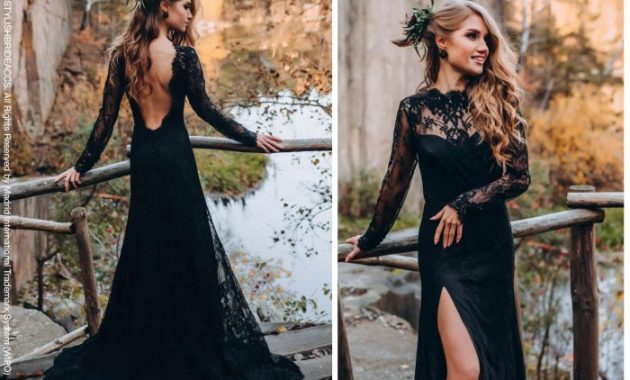A Dark Romance: Exploring the Allure of Black Wedding Dresses
Dark colored wedding dresses – For centuries, the pristine white wedding gown has reigned supreme, symbolizing purity and innocence. However, a growing number of brides are embracing a bolder, more unconventional approach, choosing dark-colored wedding dresses to express their unique personalities and defy tradition. This exploration delves into the history, design, styling, and cultural significance of this increasingly popular trend.
History and Evolution of Dark Wedding Dresses
The association of white with bridal attire is a relatively recent phenomenon, gaining traction in the 19th century with Queen Victoria’s choice for her wedding. Before that, brides wore a variety of colors, often dictated by availability and social standing. Darker hues, such as deep blues, reds, and even blacks, were not uncommon. The shift towards white signified purity and affluence, a standard that persisted for generations.
However, the 20th and 21st centuries have witnessed a resurgence of non-traditional wedding attire, with dark-colored dresses making a significant comeback.
While specific historical figures wearing dark wedding gowns for their ceremonies are difficult to definitively pinpoint due to limited photographic records from earlier eras, the concept of non-white wedding dresses was not uncommon before the widespread adoption of white. The modern revival is largely attributed to the growing acceptance of individuality and self-expression in wedding fashion. This change in societal perception allows brides to choose attire that reflects their personal style and preferences, rather than adhering strictly to established norms.
A timeline illustrating the evolution could include:
- Pre-19th Century: Varied colors, including dark hues, common depending on social class and regional customs.
- Late 19th – Early 20th Century: White becomes the dominant color, signifying purity and wealth.
- Mid-20th Century: Slight deviations from white, such as pastels, emerge but remain relatively uncommon.
- Late 20th – Early 21st Century: A significant increase in the acceptance of non-traditional colors, including dark shades, as a fashion statement.
- Present Day: Dark-colored wedding dresses are a growing and established trend, seen frequently in bridal fashion.
Design Elements and Aesthetics

Source: etsystatic.com
Dark wedding dresses offer a sophisticated and dramatic alternative to traditional white gowns. The versatility of dark shades allows for a wide range of styles and aesthetics.
Popular shades include navy, black, burgundy, emerald, and deep plum. Fabric choices often include luxurious materials such as lace, velvet, silk, and satin, each contributing a unique texture and feel. Design details can range from simple and elegant to heavily embellished, incorporating beading, embroidery, or intricate detailing.
Three distinct dark wedding dress concepts are presented below:
| Dress Name | Fabric | Silhouette | Key Details |
|---|---|---|---|
| Midnight Bloom | Black velvet | A-line | Deep V-neckline, long sleeves, delicate floral embroidery along the bodice and skirt. |
| Burgundy Rhapsody | Burgundy silk | Mermaid | Off-the-shoulder neckline, fitted bodice, dramatic train, subtle beading along the waistline. |
| Emerald Enchantment | Emerald lace | Ballgown | High neckline, long sleeves, full skirt, delicate lace appliqués throughout, subtle train. |
Styling and Accessories, Dark colored wedding dresses
Accessorizing a dark wedding dress requires careful consideration to balance the drama of the gown with the overall aesthetic. Jewelry choices should complement the dress’s color and fabric, while hairstyles and makeup should enhance the bride’s features and create a cohesive look.
Statement jewelry, such as a bold necklace or earrings, can add a touch of glamour. Veils can range from simple and elegant to dramatic and elaborate, depending on the desired effect. Shoes can be chosen to match the dress’s color or offer a contrasting element. Hairstyles can vary from sleek updos to loose, romantic waves. Makeup should be tailored to the bride’s skin tone and personal preference, with a focus on creating a polished and sophisticated look.
A visual representation of a bride in a dark colored wedding dress: Imagine a bride in a navy blue silk A-line gown with a delicate lace overlay. She wears a cathedral-length veil, simple diamond stud earrings, and classic ivory-colored heels. Her hair is styled in a loose, romantic updo, and her makeup features a soft smoky eye and a natural lip color.
Venue and Setting Considerations
The venue and setting play a crucial role in showcasing a dark wedding dress to its best advantage. The ambiance of the venue should complement the dress’s mood and style. Lighting is especially important, as it can significantly affect how the dark color appears. Careful consideration should also be given to the floral arrangements.
Suitable venues might include:
- Historic estates or castles
- Vintage-inspired ballrooms
- Rustic barns or farmhouses
- Modern art galleries or museums
Lighting should be well-planned to avoid washing out the color of the dress. Warm, romantic lighting is often preferred.
Floral arrangements should be carefully chosen to complement the dress without clashing.
Dark-colored wedding dresses offer a sophisticated alternative to traditional white gowns, making a bold statement. To complement this look, consider adding a touch of elegance with a coordinating jacket; finding the perfect one is easy with resources like women’s dress jackets for weddings , which offer various styles and colors. The right jacket can elevate a dark wedding dress, creating a truly unforgettable ensemble.
- Suitable: Deep red roses, burgundy dahlias, dark purple orchids, moody greenery.
- Unsuitable: Pastel-colored flowers, overly bright or cheerful arrangements.
Cultural and Personal Significance
The symbolism of dark colors varies across cultures. In some, black represents sophistication, elegance, and power, while in others, it may be associated with mourning or bad luck. However, the choice of a dark wedding dress is often a deeply personal one, reflecting the bride’s individual style and personality. It can symbolize strength, independence, or a rejection of traditional norms.
For some brides, a dark wedding dress represents a departure from tradition and a celebration of individuality. For others, it might symbolize a sense of mystery, elegance, or a connection to a specific aesthetic. The emotional impact can be empowering, allowing the bride to feel confident and comfortable in her own skin.
Consider the fictional story of Anya, a renowned artist known for her bold and dramatic style. Choosing a deep emerald green gown for her wedding, Anya expressed her unique personality, showcasing her artistic flair and preference for unconventional choices. The rich color mirrored her vibrant spirit and the gown’s elegant design perfectly complemented the intimate ceremony held in a historic art gallery, showcasing her artistic soul and independent spirit.
Frequently Asked Questions: Dark Colored Wedding Dresses
Can I wear a dark colored wedding dress in any season?
Absolutely! The season can influence fabric choices (e.g., heavier velvet in winter, lighter silk in summer), but dark dresses work beautifully year-round.
How do I choose the right shade of dark for my wedding dress?
Consider your skin tone, hair color, and personal style. Experiment with different shades to find one that complements your features and overall aesthetic.
Are dark colored wedding dresses more expensive than white ones?
The cost depends on the fabric, embellishments, and designer. Dark colored dresses can range in price similarly to white dresses.
What about religious or cultural considerations?
Some cultures or religions may have traditions surrounding wedding attire. It’s crucial to consider these factors and discuss them with relevant individuals before making a decision.

